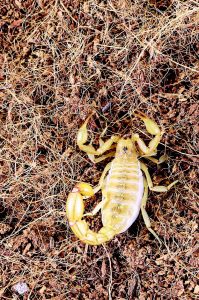Here comes Vaejovis spinigerus, also known as the Arizona Striped tail scorpion or the striped devil scorpion. Vaejovis spinigerus, or “V Spin” as resident arthropod expert John Valentin Chua calls them, is one of the most common scorpions in Arizona in the United States, but it can also be found in southwestern New Mexico and southeastern California into Mexico. Naturally, it was only a matter of time before local scorpion enthusiasts found a way to import this desert scorpion into our tropical climate.
IF LOOKS COULD…KEEL?
It typically has a light yellow to golden brown color, with brownish-tan stripes on the base of its tail. They’re also quite small—only two-and-a-half inches long for adult females, while adult males only grow to one-and-a-half inches. These scorpions have a lifespan of 8 years, on average, although in captivity this would all depend on how well you take care of them, John remarks. The name “spinigerus” comes from the spiniform granules at the ends of the dorsal keels of the tail.
So, what drew John to this particular species of scorpion? “They’re freaking cute,” he gushes, “and very active. Also, their color is golden yellow, like a toy. You can even keep them communally for a time, until one gets pregnant, or if you run out of feeders to feed them.”
NOT THAT DANGEROUS:
Although regarded as an ‘intermediate’ level scorpion by some sources on the net, with a very low sting rating of 2 out of a possible 10, they are not regarded as particularly dangerous to humans. John says, “These are not intermediate scorpions. Even a newbie could take care of them, in my opinion.”
KEEP IT HOT AND HIDDEN:
Because the striped devil scorpion comes from the deserts of Arizona, it’s best to keep its enclosure in the hottest part of the room. “A medium or large Kritter Keeper is fine, with sand as a substrate. There should be an area with dry cocopeat,” explains John.
“They don’t really need rocky substrates, they just like their environment to have lots of hides, because they’re very active and they are from the desert. But if you want to put a rock in, then by all means. Just make sure that the rock is not too heavy because it may fall on the tiny creature,” he cautions.
These creatures have a tendency to burrow under hides, because of their instinct to find shelter from the desert sun. But although internet sources recommend the use of UV light, John’s experience with his own scorps differs. “In my experience, as long as they are warm and dry, they’ll thrive. But it doesn’t hurt to at least put fine sand to make it more interesting to view them.”
When it’s time to breed, the Arizona striped tail scorpion uses both smell and vibrations to help them find their mates. When they finally do find each other (or when the keeper introduces them to each other) they may display a dance with each other, which may last anywhere from a few minutes to hours. After they are finished dancing, each will go their own separate way. But if the male stays dancing longer than the female, the female will attack and eat him. Talk about overstaying your welcome!
The offspring of this dangerous dance will then grow inside the female scorpion. A pregnant female scorpion will usually have a different posture from the other scorpions during its gestation period, which lasts for 3-8 months, and she will look inflexible and rigid.
When the time comes to give birth, the female will have lowered front legs, allowing her offspring to be born from her body alive. Sometimes they will emerge one at a time; other times, they will emerge all at once in a constant flow. These little scorplings can range from 1-100 individuals, which is quite the wide range.
After giving birth, a female will care for her scorplings and carry them on their back until they undergo their first molting. But depending on the environmental factors, a mother scorpion may sometimes eat her scorplings instead.
Although this particular scorpion is known to be parthenogenetic when the conditions are right, in John’s experience they tend not to be, especially in the Philippine climate. “It’s quite hard to get the right temperature for them to ‘pop’,” he says.
This appeared in Animal Scene magazine’s August 2017 issue.







